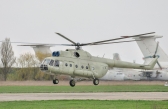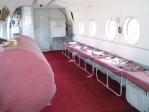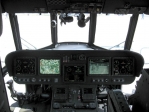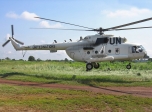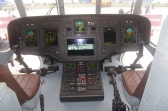.jpg)
The Mi-8 is a base version of the transport helicopter available in civil and military versions. It's cockpit accommodates three crew members - commander, navigator, and flight mechanic. The cockpit can be armored (military version). The helicopter has external hardpoints for external armament such as unoperated aviation missiles, bombs and a slung load. A slung load is up to 3 000 kg. Helicopter's landing-transport equipment can be used to load light towed combat material and armament with winches and for people rescuing from the ground or from the sea by an electrically operated 200 kg capacity hoist. The cabin has cargo tiedown points on the floor. Ramps are provided for loading light vehicles. Fuel is carried in two flexible internal and external fuel tanks (1 870 l capacity both). Range of flight with normal load is 465 km. However the fuel capacity can be increased up to 3 700 l for 950 km flying range. The Mi-8T "Hip" uses aviation kerosene. Development of the Mi-8 Helicopter began at the beginning of 60-ties. Helicopter's name as Mi is shortened it's general designer's surname. This helicopter was intended to replace the outdated and lighter Mi-4 helicopter. First prototype of the Mi-8 with a 4-blade rotor was tested in 1962. Tests showed that prototype has a number of disadvantages and after it's improvement in 1963 began tests of the second machine with a 5-blade rotor. Tests showed that this new transport helicopter had 2.5-fold better weightlifting and 1.4-fold higher speed comparing with the Mi-4. This version was adopted and it's serial production began in 1965. Fuel is carried in two flexible internal and external fuel tanks (1 870 l capacity both). Range of flight with normal load is 465 km. However the fuel capacity can be increased up to 3 700 l for 950 km flying range. The Mi-8 "Hip" uses aviation kerosene. Cockpit of the Mi-8 Helicopter
Helicopter has a transmission scheme very similar to the Mi-4. Fuselage is clinched from aluminum plates. Main and turn rotors have 5 and 3 blades consequently. The main rotor features hollow longeron blades made from pressed high quality aluminum alloy. Longerons are fitted with icing prevention system's heating elements operated in automatic or manual modes. All main rotor blades are fitted with pneumatic failure alarm system.
The Mi-8 "Hip" Transport Helicopter is powered by two Klimov TVZ-117 type turboshaft engines. Engine air intake deflectors prevent ingestion of dust. It is also fitted with electricity generator, hydraulic pumps, cooling fan. The Mi-8 Helicopter engines are ignited by reaction starter motor which can be used as additional electricity source. In case of one of the main engine failures during flight the other main engine power is increased. One engine power is enough to keep horizontal flight without loosing altitude. This feature determines high helicopter flight safety and reliability.
Helicopter has a three bearing fixed chassis fitted with a rubber wheels. Both rear bearings have absorbation devices. The Mi-8 "Hip" is fitted with fire prevention, icing prevention, air conditioning systems.
Protection systems contains exhaust gas spreading, infrared trap launching, and infrared beam impulse generation systems to counteract against enemy guided missiles based on infrared guidance. Helicopter is fitted with an explosion resistant foam filled fuel tanks.
Navigation, piloting, and radio equipment completed with Mi-8 allows to make flights at any day-night time and meteorological conditions. Piloting control system is doubled and based on hydraulic mechanisms. Helicopter is fitted with a four-channel autopilot stabilizing the helicopter in 4 flight coordinates - axis and height, course, alteration, and speed. Navigational devices contain doubled aviahorizont, giromagnetic course compass, radio altitude finder, Doppler effect based speed and side deflection meter.
Threw the helicopter improvement and redesigning for special tasks works there were developed later mentioned and a number of other modifications:
- Mi-8P - Passenger Helicopter used in the civil air lines and for commercial purposes. This helicopter has 28 passenger seats; - Mi-8S - Improved Passenger Helicopter; - Mi-8PS - Improved comfort luxury Passenger Helicopter intended for 7 - 11 VIP passengers. Such helicopters are built on special orders in limited editions for presidents and government members. M. Gorbachiov and B. Jelcin had this helicopter; - Mi-8TV - Military Transport Helicopter with increased armament. It is an armored variant of the Mi-8T Helicopter. In addition it has increased reinforced external hardpoints for slung load up to 4 000 kg and armament. The turning screw was placed from left side what made it more effective. It is fitted with 7.62mm built-in machine guns and six external weapons racks with S-5 aviation missiles. The helicopter can also carry AT-2 Swatter 9M 17P "Scorpion" anti-tank missiles. Mi-8TV is also capable of laying minefields. The helicopter has more powerful TV3-117VMA engines that provide increased hovering ceiling in 3 950 m compared to the 1 760 m compared with the Mi-8TM. The helicopter can be fitted with an infrared jammer; - Mi-8TBK - Export variant of the Mi-8TB Helicopter: - Mi-8ATM - Amphibious Helicopter; - Mi-8TM - Improved Multipurpose Helicopter. This helicopter was designed for improved capabilities at a high altitudes and hot climate zones. The helicopter has a hovering ceiling in 1 760 m. It is some kind of conversion into a Transport-Attack Helicopter. It was completed with more powerful TV3-117MT - 1 950 hp. engines with additional gas turbine. It has cruise and maximum speed of 240 and 250 km/h consequently with a normal payload. These helicopters were involved into Soviet Union-Afghanistan War in 1979 - 1988; - Mi-8TMV/Mi-17 - Improved Multipurpose Helicopter with improved capabilities at a high altitudes and hot climate zones with increased armament. The Mi-8TMV was intended for the Soviet Army while the Mi-17 is it's export name. The helicopter is completed with more powerful TV3-117VMA - 2 200 hp. engines. It has a hovering and service ceilings in 3 980 and 4 900 m consequently; - Mi-8MTV-2/Mi-17-1V - Heavy Armed Multipurpose Helicopter one of the most powerful in it's class. This helicopter improvement works are made recently. It has armed with 4 aviation guns, unoperated aviation missiles, and various bombs. There is ability to mount 8 machine Civil version of the Mi-8 - most likely the Mi-8S Passenger Helicopter guns in the fuselage side windscreens; - Mi-14 - Amphibian Anti-Submarine Helicopter built on Mi-8TM base and entered service in 1977; - Mi-8VZPU - Electronic Warfare Helicopter; - Mi-9 - Radio Retranslation Helicopter. One of it's functions was to take part in the informational war; - Mi-8PP and Mi-8PPA - Helicopters intended to generate radio electronic strays. Such helicopters were intended to block enemy communication systems; - Mi-8BT - Sea Mine-Trawling and Mining Helicopter; - Mi-8TZ - Fuel Carrier; - Mi-8R - Reconnaissance Helicopter; - Mi-8VKP - Air Command Post; - Mi-8K - Artillery Reconnaissance and correction Helicopter; - Mi-8AV - Miner Helicopter; - Mi-8MPS - Sea Search and Rescue Helicopter. Such helicopters is fitted with radio-beacons to mark the dirrect zone. It carries rescue team and can lift 10 people at a time on a sling with light rescue raft. It is completed with an emergency landing device on sea for up to 30 minutes drift. The Mi-8MPS has increased fuel capacity, additional radar system, thermal search system, navigation system and rescue equipment. These helicopters are used for a spacecraft recovery missions. It delivers technical groups with rescue equipment to the craft landing zone. It returns to a nearest aerodrome cosmonaut and space objects up to 3 000 kg weight. - Mi-8ATS - Agricultural Multipurpose Helicopter.
General characteristics:
Crew: 3 (pilot, copilot, flight engineer)
Capacity:
- 24 passengers or
- 12 stretchers and seat for 1
- medical attendant or3,000 kg (6,600 lb)
Length: 18.17 m (59 ft 7 in)
Rotor diameter: 21.29 m (69 ft 10 in)
Height: 5.65 m (18 ft 6 in)
Disc area: 356 m² (3,832 ft²)
Empty weight: 7,260 kg (16,007 lb)
Loaded weight: 11,100 kg (24,470 lb)
Max. takeoff weight: 12,000 kg (26,455 lb)
Powerplant: 2 × Klimov TV3-117
Mt turboshafts, 1,454 kW (1,950 shp)
Performance:
Maximum speed: 260 km/h (140 kt)
Range: 450 km (280 mi)
Ferry range: 960 km (596 mi)
Service ceiling: 4,500 m (14,765 ft)
Dimensions:
L - 25.24mW (rotor diameter) 21.29m H - 5.65m
Weights: 7160 kg (empty)12,000 kg (max loadout)
Max Speed: 225 kphRange 930 km
Armament:
Up to 6x 32 rocket podsSteerable 12.7mm
machine gun in nose turretVarious wire-guided anti-tank missiles
(usually at-2 swatter)
7.62mm or 12.7mm door guns2x 12.7mm gun podsbombs
Avionics:
Doppler NavigationProvision for IR jammers / Flare & Chaff Launchers

